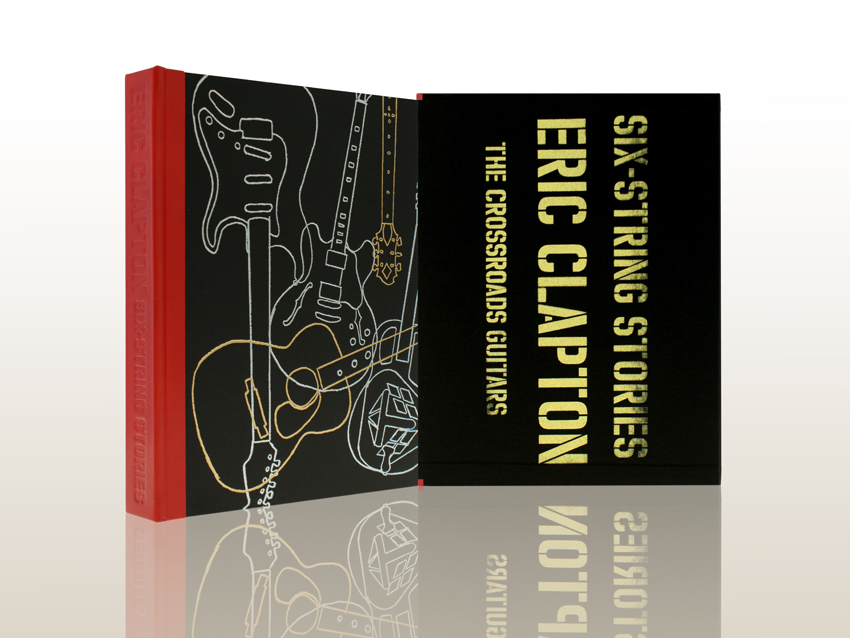
Book excerpts: Eric Clapton - Six-String Stories in pictures
Nearly 300 pieces from Eric Clapton's personal collection – guitars, amps, and other pieces of musical equipment – are presented with loving detail in Six-String Stories, a stunning new limited-edition tome from Genesis Publications.
Many of the guitars documented in the book have achieved iconic status via landmark recordings, most notably a trio of Holy Grail axes: Brownie, Clapton's 1956 Fender Stratocaster; Blackie, his composite Strat built from parts of 1956 and '57 models; and the 1964 ES-335 first heard during Eric's Yardbirds days. All have gone on to serve perhaps a greater purpose in their later years, as the guitarist has sold them (for record prices at their time of sale) in three auctions, from 1999-2011, to benefit the Crossroads Centre, a drug and alcohol treatment facility in Antigua that Clapton founded in 1997.
Using Clapton’s own words, along with background information and gorgeous photography, the instruments are presented in chronological order, serving as a visual and editorial history of the guitarist's incredible career. Six-String Stories is presented as a 2,000 piece limited-edition with each copy signed by Eric Clapton, hand-bound in cherry red leather to match Clapton’s famous Gibson ES-335, with gold and silver blocking, housed in a silk-screened buckram slipcase. The book's 376 pages are edged in gold.
"One by one these guitars were the chapters of my life," Clapton says. "They belong to a very well-loved family."
Six-String Stories can be purchased at this link from Genesis Publications. On the following pages, we are proud to present excerpts of the book, 12 guitars that have made magic in the hands of Eric Clapton.
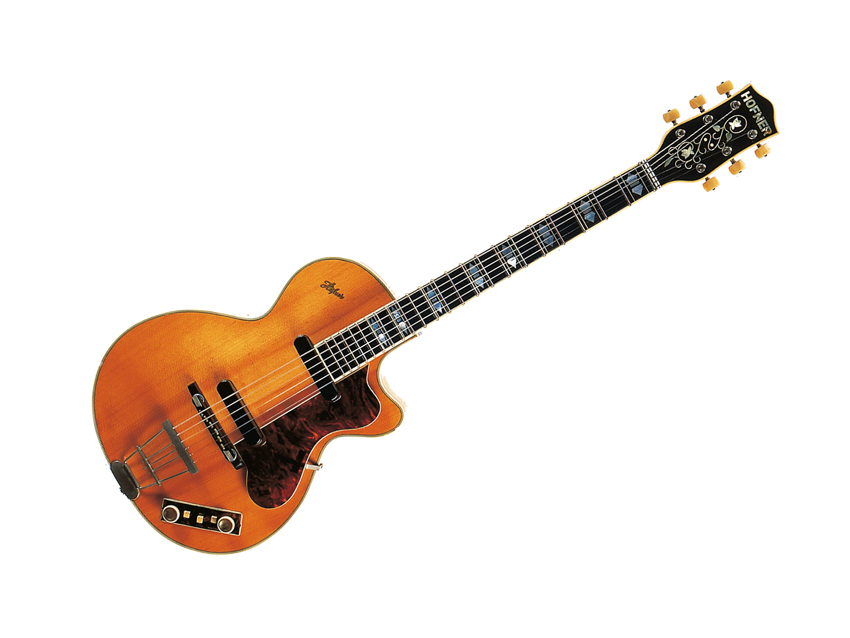
1959 Hofner Club 60
Serial No: 376
Body: Laminated maple, hollow, spruce top, bound, single round cutaway, natural finish
Neck: Maple, 22 frets, bound ebony fingerboard with bow-tie inlays
Headstock: Inlaid floral motif
Bridge: Ebony with four saddle slots, nickel-plated brass trapeze tailpiece
Pickguard: Imitation tortoiseshell
Pickups: Two Hofner high-sensitivity black bar single-coil
Controls: Two volume
Switches: Two pickup on/off, rhythm/solo
Case: Black hardshell contour case with blue plush lining and handwritten adhesive paper label ‘Hofner #376’
ERIC: "I remember seeing this model as the top-of-the-range guitar in the Hofner catalogue when I was 13 years old. When I was a little kid they were kind of big. They were rock and roll guitars; everyone wanted a Hofner."
Imported American electric guitars were prohibitively expensive in England during the late 1950s, but instruments made in Europe by companies such as the German Hofner company provided a more affordable, high-quality alternative. George Harrison, John Lennon, and Paul McCartney all played Hofner Club 40 guitars early in their musical careers; Ritchie Blackmore’s second guitar was a Club 50; and David Gilmour and Justin Hayward both bought the Club 60 – Hofner’s top-of-the-line electric model – during the early 1960s. Clapton’s former manager Roger Forrester gave Eric this Hofner Club 60 as a Christmas present in the 1990s.
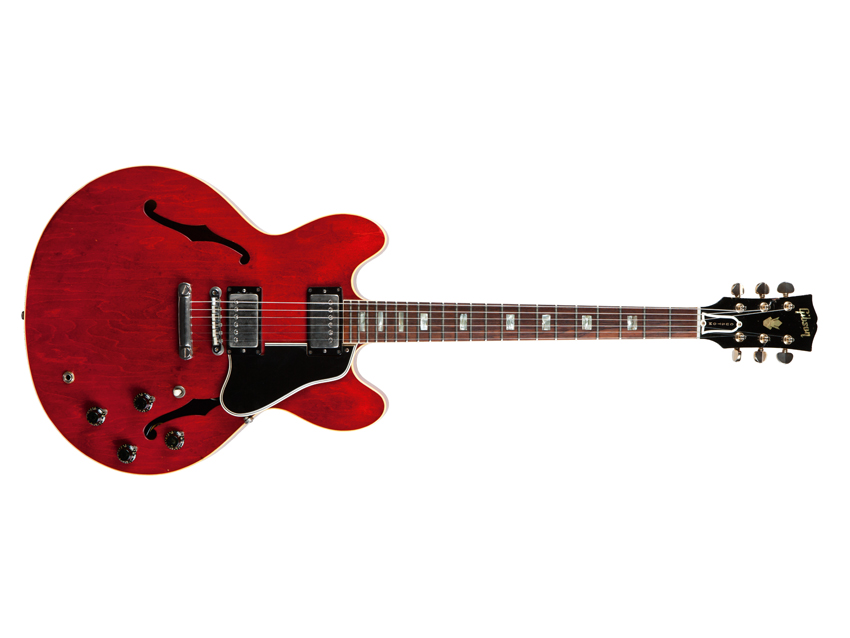
1964 Gibson ES335-TDC
PRICE: $847,500
LOT 41 CHRISTIE’S 2004
EST: $60,000 - $80,000
WORLD AUCTION RECORD FOR A GIBSON GUITAR AT TIME OF SALE. THIRD HIGHEST PRICE PAID FOR A GUITAR AT TIME OF SALE.
Serial No: 67473
Body: Double cutaway thinline semi-hollow, maple, f-holes, maple centre block, cherry red finish
Neck: Mahogany, 22 frets, rosewood fingerboard with block inlays
Headstock: Pearl Gibson logo, crown inlay, black three-ply (black/white/black) truss cover engraved ‘Custom’
Bridge: Nickel-plated Tune-o-matic with stop tailpiece
Pickguard: Black five-ply (black/white/black/white/black)
Pickups: Two humbucking with nickel-plated covers
Controls: Two volume, two tone
Switches: Three-position pickup selector
Label: ‘Style ES-335 TDC/Gibson/Number67473 is hereby/Guaranteed/against faulty workmanship and materials./Union Made/Gibson Inc/KalamazooMichigan,/U.S.A.’
Case: Original Lifton hardshell case, stencilled on the lid in white ‘CREAM/DELICATE/HANDLE WITH CARE/DELICATE ELECTRONIC INSTRUMENT/ HANDLE WITH CARE/EC G ES’, with adhesive tape inscribed ‘Auction (SADLY!)/Gibson Cherry Red-Cream/’64-335-#67473’
ERIC: "The second electric guitar I ever bought. The Kay got me into The Yardbirds, and then when we started making money, I found I had nothing else to spend it on but guitars. Though we weren’t yet in the big-money league, we were making enough for me to buy my first really serious guitar, a cherry red Gibson ES-335, which was the instrument of my dreams, of which the Kay had been but a poor imitation.
"Maybe once a month throughout The Yardbirds I bought a guitar. The unfortunate thing was I didn’t keep them. In those days, I was less of a collector. I didn’t have the money or facilities. I wasn’t really sure where I was living half the time, and it would have been cumbersome to have had more than two or three guitars. It wouldn’t have occurred to me to think, ‘Oh, for this song I’ll use that’ – I wouldn’t have thought like that at all.
"I just was very focused on a guitar and would play that exclusively for a year, two years and then for some reason I’d go somewhere else. The only one I held on to was the ES-335; it was the oldest guitar in my collection. Well, not the oldest, but the one I had the longest.
"Throughout my life I chose a lot of my guitars because of the other people who played them, and this was like the one Freddie King played. In The Roosters, Tom McGuinness brought in ‘Hideaway’ by Freddie King, and the B-side was ‘I Love The Woman’, which is still one of the greatest. That’s the first time I heard that electric-lead-guitar style, with the bent notes. I’d never heard anything like it, and it was what immediately made me want to carry on. I knew that was where I belonged, finally. That was serious, proper guitar playing, and I haven’t changed my mind since.
"I still listen to his music in my car or when I’m at home and I get the same boost from it that I did then. There wasn’t a great deal of footage or still photos or album covers that I could refer to that showed examples of this model, but I did see a Freddie King instrumental album and he was playing one of these. I think the cherry Gibson ES-335 was really acceptable on every front. It was a rock guitar, a blues guitar – the real thing.
"Even in those days I may have had reservations about Fenders, in that they were solid, whereas this one was semi-acoustic. What I love about Fenders now I would probably have held in a little bit of contempt in those days, in that they didn’t have any purfling down the side of the neck, and so on. This guitar had all the finish you would ever want and all the credibility a guitar needed at that time. The fact that Alexis Korner and I played those Kays was because you couldn’t get these Gibsons in England – you didn’t see them. You got copies, German guitars like Hagstroms, Hofner. I bought this brand new either from Denmark Street or Charing Cross Road.
"The ES-335 is beautiful, and I loved it. It was played regularly over the years. It got on albums, it never really changed. It never got old, it never wore down. It never lost anything. I’d play it now.
"Anything that’s been that long in my life and is still functional – there aren’t too many things that can command that kind of respect. I’ve had no cars that long for instance. There are no other tools in my life that have been as long-serving. After I sold the red ES-335, I bought a sunburst one. It’s a great guitar and it’s so loud. I’d forgotten how loud they were."
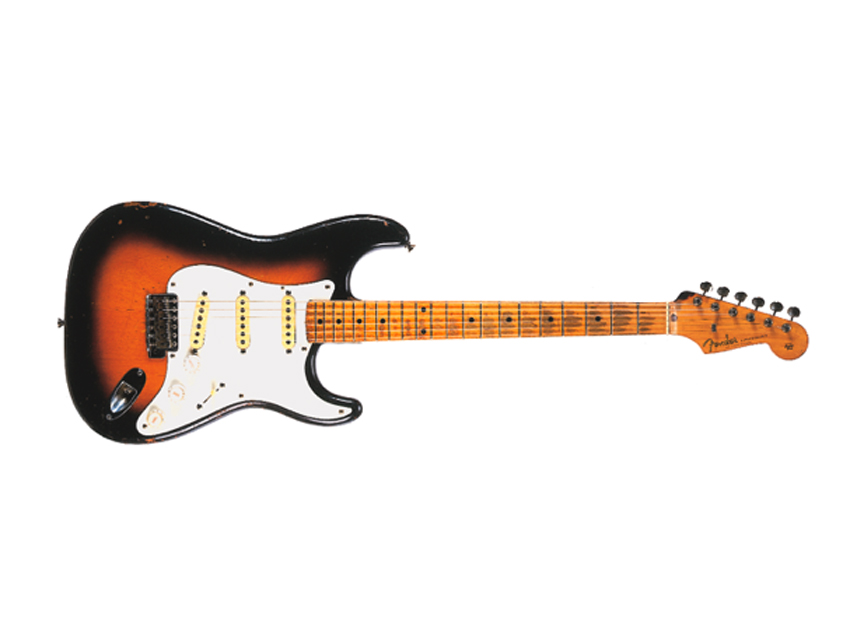
1956 Fender Telecaster "Brownie"
PRICE: $450,000
LOT 105 CHRISTIE’S 1999
EST: $80,000 - $100,000
Serial No: 12073
Body: Alder, sunburst finish, dated 6-56
Neck: Maple with skunk-stripe truss rod routing, 21 frets, maple fingerboard with dot inlays. Neck date and initials XA-6-56 written in pencil
Bridge: Synchronised tremolo
Pickguard: White single-ply
Controls: One volume, two tone
Pickups: Three single-coil
Switches: Five-position pickup selector with white switch tip (replaced original three-position pickup selector sometime in the 1970s)
Additional: Red guitar strap
Case: Black rectangular hardshell case stencilled on both sides in yellow ‘DEREK AND THE DOMINOS’ and ‘FRAGILE’ and handwritten tie-on label inscribed ‘1956 Strat #12073 2TSB BR’
ERIC: "I don’t think there’s anything on the Stratocaster that doesn’t come from pure logic. I would challenge anybody to come up with a better design for a guitar. The Stratocaster is as good as it gets, isn’t it?
"With Delaney and Bonnie I used my old Stratocaster, Brownie, which was really, really good – a great sound. It was just right for the kind of music I was playing with them.
"I never met Leo Fender, but I wish I had. If I could go back and somehow talk to him about the Stratocaster, I’d say, ‘You’ve created something that can’t be bettered, really. How did you do that?’ I know there were prototypes with the Telecaster and the Esquire, and some early experimental stages, but nevertheless, the fact that he got to this conclusion so quickly is remarkable.
"Leo Fender was so far in advance of anybody else, developing the Strat to the point where it just couldn’t be bettered, even now. My hat’s off to him. I think Brownie dictated the way I played to a certain extent. Because the Strat has less sustain – it’s harder to bend on and harder to hold the bends and apply vibrato – I play more notes.
"I didn’t look at the change from Gibson to Fender as ‘I’m done with that.’ It was more a case of wanting to try something else. In the early days I had predominantly played a Gibson Les Paul. The Les Paul had completely knocked the Strat out of the public eye back then. Everyone was playing Les Pauls (page 52) and 335s (page 26) and other guitars like that.
"I had a lot of influences when I took up the Strat. Everyone thought, ‘What do you want with these? Nobody plays these anymore,’ but Buddy Guy was playing one, Steve Winwood was playing one, and Buddy Holly played one. You could really hear the Strat on Hoodoo Man Blues by Junior Wells with Buddy Guy. It was so immediate. You heard the sound of the wood, and I wanted to pursue that sound. Buddy Holly played a sunburst Strat with a maple neck, and that became my Holy Grail.
"For me the whole thing went back to the cover of The “Chirping” Crickets, the first album I ever bought. There was a picture of a Stratocaster on it, so it’s been iconic for me from year one. When I got my hands on one, I was surprised at how easy it was to play. One reason why I hadn’t played Strats earlier in my career was that the necks always looked so narrow. I thought, ‘I won’t be able to bend any strings, no room,’ but in fact I was wrong.
"Picking up a Stratocaster makes me play a bit differently. I find that I play more with my fingers because of the way my hand sits on the guitar. I don’t feel the need to use a pick quite so much as I would with any other guitar, where the bridge sits higher off the body. With the Strat the bridge is almost flush with the guitar, so my hand rests on the body, part of my heel rests on the bridge, and then my fingers rest on the scratchplate. It’s really easy to play either way, but I’ve found more and more that I’m using just my fingers.
"It’s got those famous lead tones, but it’s so versatile you can use it in any kind of rhythmic sense as well – great big power chords, or that really light kind of Tamla/Motown chord sound with very little volume. Unlike most other electric guitars, it sounds almost better when the guitar’s volume knob is on two or three, really under-amplified and quiet.
"Brownie was the last guitar to be sold in the 1999 Crossroads auction and when it was brought out onto the revolving rostrum, they played ‘Layla’ over the PA and the whole audience stood up. I had no idea what ‘Layla’ was going to be. It was just a ditty. When you get near to the end of it you know you’ve got something really powerful. I’m incredibly proud of ‘Layla’. To have ownership of something that powerful is something I’ll never be able to get used to. But the funny thing was that once I’d got ‘Layla’ out of my system I didn’t want to do any more with the Dominos. I didn’t want to play another note."
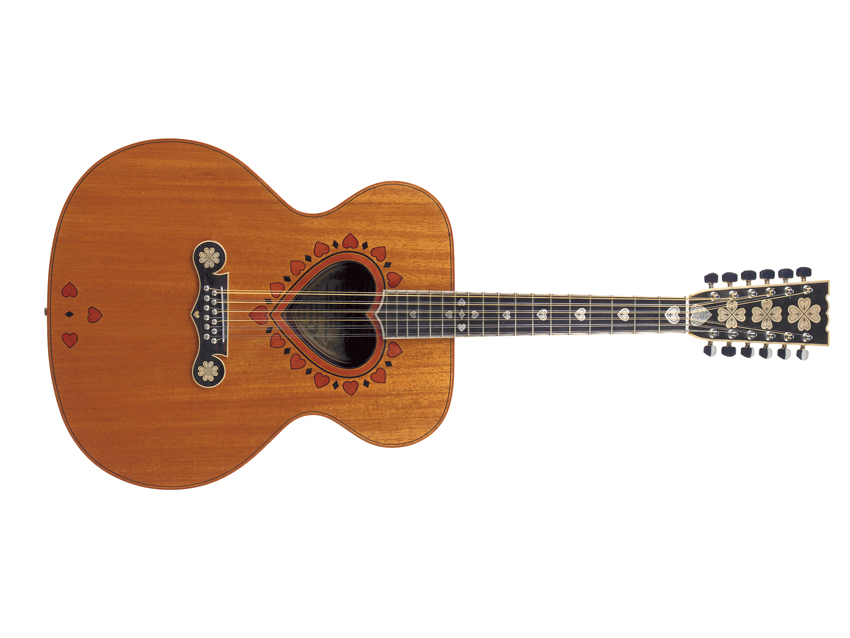
1966 Zemaitis Custom 12-String "Ivan The Terrible"
PRICE: $253,900
EST: $30,000 - $50,840
LOT 33 CHRISTIE’S 2004
Body: Rosewood back and sides, cedar top, decorative back stripe with heart inlays, inlaid heart motif on top’s lower bout, natural finish
Neck: Seven-ply laminated maple and walnut, 18 frets, bound ebony fingerboard with silver heart inlays, silver nut
Headstock: Three silver four-leaf clover inlays, silver heart-shaped truss rod cover engraved ‘Eric Clapton’
Bridge: Ebony pin bridge with silver four-leaf clover inlays, silver engraved bridge pins and saddle
Soundhole: Heart-shaped with purple heart amaranth heart inlays, ebony edging
Label: ‘Engraving D. O’Brien/Zemaitis/Hand-Made Guitars/Commissioned & Co. Designed/By/Eric Clapton esq/London/1969’, signed and dated by maker ‘Antonius Casimere Zemaitis 1969’. Label is heart-shaped and made from hand-illuminated parchment
Case: Anvil hardshell case with adhesive tape inscribed ‘Auction #54/Zemaitis ‘Ivan’ 12 St.’
ERIC: "I finally got to meet Tony Zemaitis in the mid-Sixties. I asked him to make a 12-string for me, bigger than he’d ever done before and inlaid with silver. I wanted it to be incredibly ornate. I wanted to explore everything we could. The heart shape and the four-leaf clover on the headstock were my ideas.
"So he made this guitar, it probably took about a year, and it was massive. It’s reputed to be the biggest 12-string in the world. It’s about the same dimensions as a mariachi bass. Tony really did a beautiful job. I used it with Blind Faith and I did some other material with it.
"I was involved in a very, very stormy relationship at the time. During one of our big rows, I took the guitar and I demolished it. I took it by the neck and I banged it against the wall until there was nothing left. Then about five years later – I still had the neck – I took it back to Tony and said, ‘I’ve got to tell you a terrible story, forgive me I can’t bear to be without it,’ and I apologised and made all the excuses I could think of. He was shocked, but he understood, so he built another body onto the neck. So this is Mark 2 – the first one was destroyed, but the neck is original."
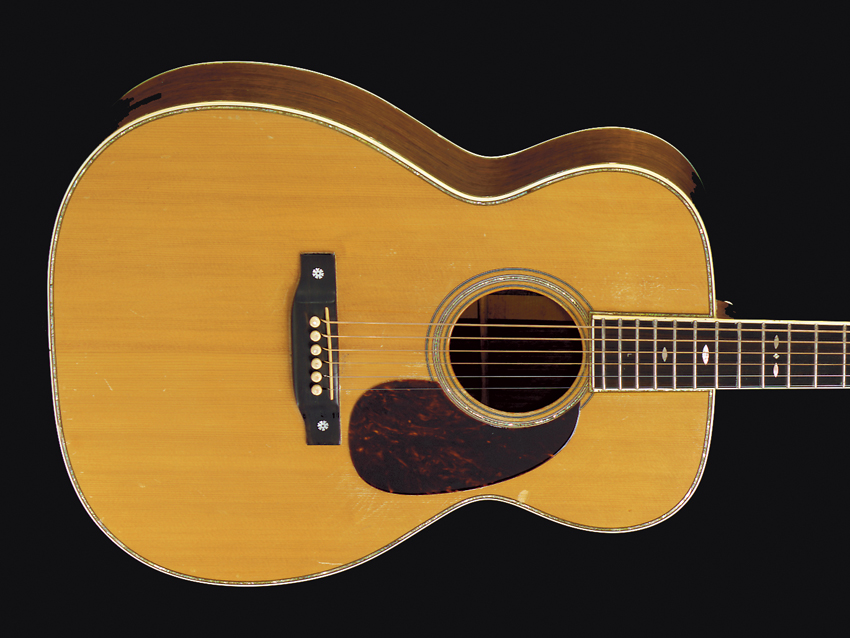
1966 Martin OOO-28/45 conversion
CONVERSION PRICE: $186,700
LOT 16 CHRISTIE’S 2004
EST: $20,000 - $30,000
Serial No: 208511
Body: Rosewood back and sides, spruce top, ivoroid binding with pearl purfling, natural finish
Neck: Mahogany, 20 frets, bound ebony fingerboard with ‘snowflake’ inlays
Headstock: Ivoroid binding, vertical ‘C.F.Martin’ logo inlaid in pearl
Bridge: Ebony ‘belly’ pin bridge, dot inlays
Soundhole: Pearl inlaid rosette
Pickguard: Imitation tortoiseshell
Label: ‘This instrument inlayed by Custom Pearl Inlay Service, 200 Hemphill Avenue, Chattanooga Tenn. 37411, work performed 000-28-45 No 67 April 11, 1966, Mike Longworth’
Case: Later hardshell case with adhesive tape inscribed ‘Longworth/Martin: 000-28-45 #208511’
ERIC: "The Martin thing started with having seen pictures and footage of Big Bill Broonzy playing a 000-28 – the narrow-waisted acoustic guitar. When I started to hang out in London at the folk clubs all those guys wanted the big country guitar with the dreadnought body. I thought that shape was lovely but I was still drawn to the Big Bill Broonzy image and the sound he got too.
"The Longworth is the first serious Martin that I ever bought. I got it from GTR when I was doing The Johnny Cash Show in 1970. It’s a great guitar, a star guitar. It has all the Bakelite and mother-of-pearl inlays. After this guitar I was kind of easy game for anything vintage from Martin. But of course it would have to play well.
"This guitar has a deep association for me. It’s as important to me as the Rodeo Man guitar (page 136). In fact, much more so. I used this all through the Seventies on stage, from the time that I was doing 461 Ocean Boulevard and taking that material on stage. It was incredibly well used. After the Dominos, when I went on tour billed simply as Eric Clapton, I actually went onstage starting with an acoustic set. I did three or four songs with the Martin acoustic – and then got into some rock and roll and a few blues."
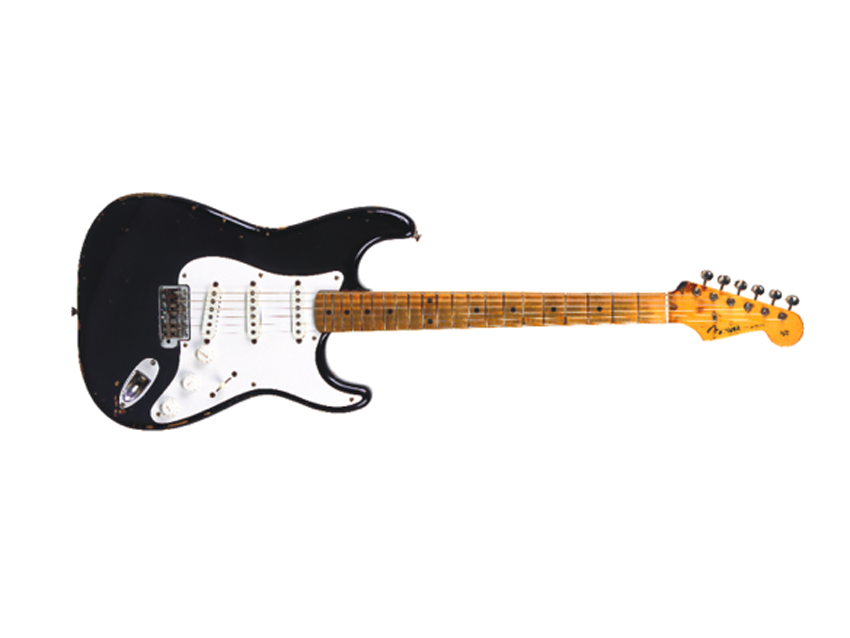
Fender Blackie Stratocaster, 1956 +57 composite
PRICE: $959,500
LOT 88 CHRISTIE’S 2004
PRE-SALE EST: $100,000 - $150,000
WORLD AUCTION RECORD FOR A GUITAR AT TIME OF SALE*
Serial No: 20036
Body: Alder, black finish
Neck: Maple, 21 frets, maple fingerboard with dot inlays
Bridge: Synchronised tremolo
Pickguard: White single-ply
Pickups: Three single-coil
Controls: One volume, two tone
Switches: Three-position pickup selector with white switch tip
Case: Anvil case stencilled in white with an image of two cartoon duck heads and lettering ‘THE/DUCK BROS./LONDON 01 486 8056’ with adhesive tape inscribed ‘Auction #15/BK/’56 ’57 Black/Stratocaster’
ERIC: "The guitar I chose for my return to recording was one that I had built myself, a black Fender Stratocaster which I had nicknamed ‘Blackie’. It’ s probably a well-known story… I went into a shop in Nashville called Sho Bud which was owned by Buddy Emmons – the famous pedal steel player – and they had things like Rickenbackers in the front of the shop going for quite high prices. In the back they had this second-hand department and there was a row of Stratocasters, almost like clothes on pegs.
"I couldn’t believe that Strats had sunk so low in public opinion. I felt like I’d stepped into a gold mine. Blonde, maple neck Stratocasters, all going for about $100-150 each, and I bought them all. When I got home I gave one to Steve Winwood, one to Pete Townshend, another to George Harrison and kept the rest. Blackie was made out of three of these guitars – the body of one, the neck of another, the pickups of another. If I hadn’t bought those guitars they probably would have been firewood and now the cost of 1950s Strats is ridiculous.
"They’re things of great beauty. Now the vintage Strats have all gone. That particular avenue has probably dried up unless someone finds one under their bed. They go into collections and they don’t come out again. You’d have to be quite wealthy to even think of buying one.
"Something is just magical about that guitar. Maybe it’s all the tender-loving care I’ve given it over the years. That’s probably why I like buying second-handmguitars and old vintage guitars. This may sound superstitious, but you never know who owned a guitar before. That person may have been a master and he may have put something in there. The way the guitar was played and handled seems to stay with the guitar and you inherit that if you’re lucky or aware enough to acknowledge it.
"When I came back to recording, it was with a different point of view, a fresh enthusiasm and a kind of open-mindedness to learn about new music, because that’s when I heard reggae. I was just like a kid in a sweet shop again. When we were recording 461 Ocean Boulevard , we’d walk into the studio and jam, and then we’d listen to it back and write the song. We’d pick out a riff, or part of the jam that was good and then write a song with it. We really got it going in the end.
"I get seriously attached to an instrument and I felt that Blackie had become part of me. A guitar like Blackie comes along maybe once in a lifetime. I played it for 12 years non-stop on the road. Brownie (page 72) was a much more industrial guitar. Blackie was really refined, it was like the racer. The action was perfect even when the neck was quite worn down and narrow. All you had to do was pick it up and it played itself. I developed a lot of trust and security with that instrument. It’s a remarkable guitar.
"It was hard for me to part with Blackie but I had to put it into perspective. My working relationship with Blackie was exclusively and extensively through the Seventies and early Eighties and then after that it was removed from working life. On tour with the Dominos, Blackie got some incredibly bad treatment. When I was playing with the guys from Tulsa – Jamie Oldaker, Carl Radle – I remember ending a song by falling face down on stage on top of Blackie. I cracked the nut and it just shattered.
"Apart from that the guitar was fine. I think the old repair on Blackie’s headstock was originally there when I got it. The reason I chose that neck was because it’s got quite an extreme V. It’s the most extreme V on a maple neck that I’ve found. It was a beautiful neck and had a lovely feel. I think even today that Blackie would be my ideal. If you asked me to pick the classic Fender, it’s a black Strat with a maple neck."
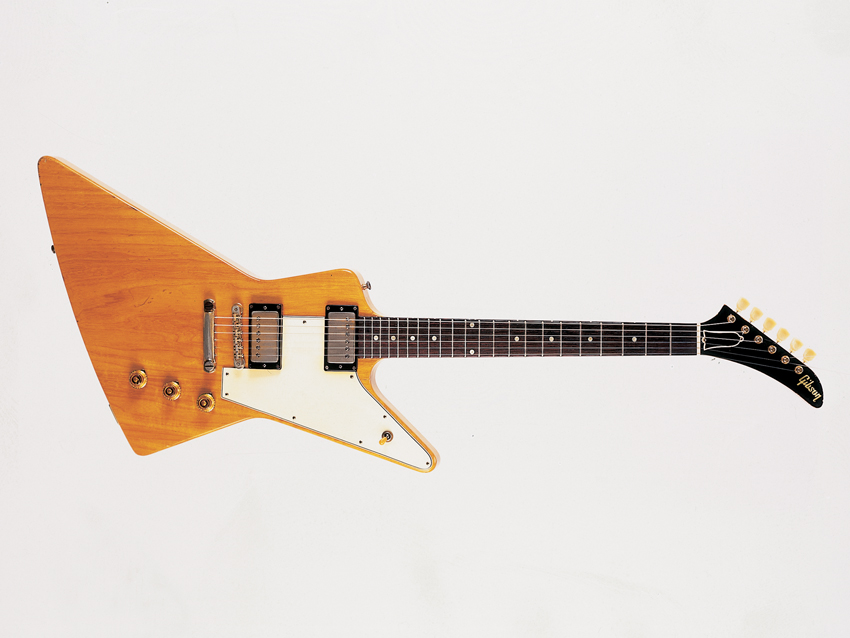
1958 Gibson Explorer
PRICE: $120,000
LOT 92 CHRISTIE’S 1999
EST: ON REQUEST
Serial No: 8 4541
Body: Korina, natural finish
Neck: Korina, 22 frets, rosewood fingerboard with dot inlays
Headstock: ‘Scimitar’ shape, pearl Gibson logo inlay
Bridge: Gold-plated Tune-o-matic, gold-plated stop tailpiece
Pickguard: White three-ply (white/black/white)
Pickups: Two humbucking with gold-plated covers
Controls: One volume, two tone
Switches: Three-position pickup selector
Additional: Set of single-stripe Kluson Deluxe gold-plated tuners and strap
Case: Black rectangular hardshell case with brown plush lining and handwritten tie-on label ’’58 Gibson Explorer 84541’ and adhesive paper label similarly inscribed The ARMS London Benefit Concert Royal Albert Hall London, UK Sept. 20, 1983 Eric Clapton is playing his Gibson Explorer on stage alongside Bill Wyman.
ERIC: "Obviously the ARMS benefit was a concert I very much wanted to do both on behalf of Ronnie, and on behalf of the Action Research into Multiple Sclerosis Fund. But that didn’t mean I wasn’t nervous. Far from it – I was petrified when we had the first rehearsals. But it rapidly became great fun. It was a delight to work with such a competent bunch of musicians.
"Originally the idea was for everyone to just loosely jam together, but subsequently it was quite rightly decided that everyone involved should do their own little regular sets, with the rest of the band providing the backing. We were all playing together for the first time, and because we were doing it for Ronnie rather than for money, we left our egos at the door and it was great."
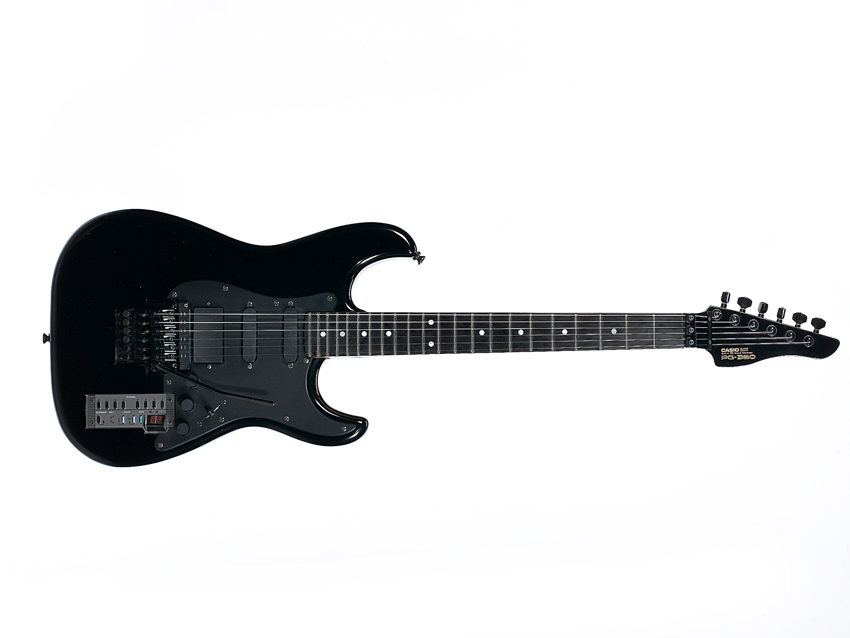
1987 Casio PG-380 MIDI Guitar
EST: $600 - $900
PRICE: $9,000
Serial No: T00093
Body: Alder, black finish
Neck: Maple, 22 frets, ebony fingerboard with dot inlays
Headstock: Back of headstock signed by Eric Clapton in black felt pen
Bridge: Floyd Rose-licensed locking tremolo
Pickguard: Matt black single-ply
Pickups: Two single-coil, one humbucking, one hexaphonic
Controls: One guitar volume, one synth volume, one tone/pull coil split
Switches: Five-position pickup selector, eight programme, octave up, octave down, tuner, card
Other: Two-digit LED, MIDI Out connector, guitar output jack, synth output jack, RAM/ROM card slot
Case: Black rectangular hardshell case with tangerine plush lining, two labels inscribed ‘E.C. Black Casio Synth Guitar’
ERIC: "I wrote most of the songs for the Behind the Sun album on synthesizers. I’d run out of ideas on the guitar. Synths sounded so great, writing was easier."
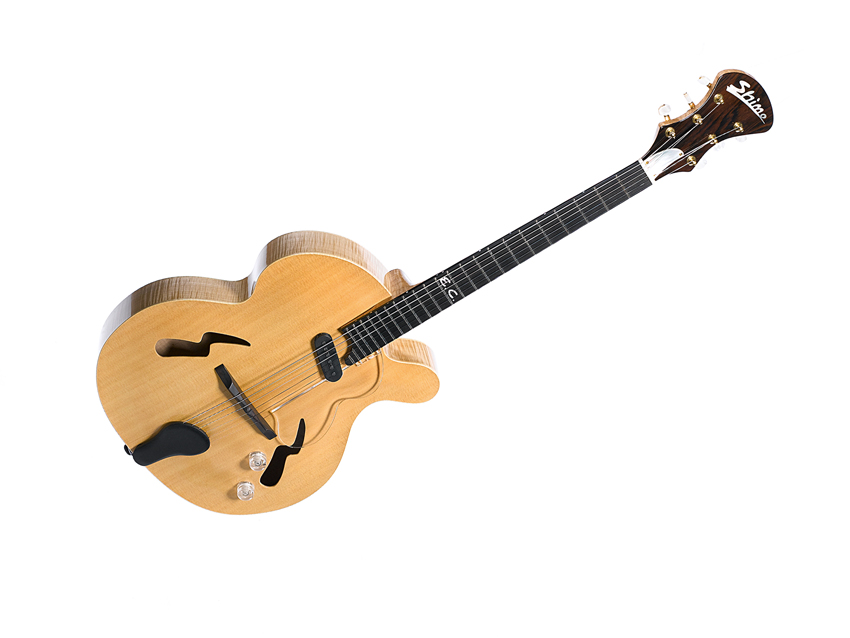
2002 Shimo Sally
PRICE: $7,000
LOT 69 BONHAMS 2011
EST: $1,500 - $2,000
Serial No: 082
Body: Figured maple back and sides, spruce top, maple binding, ‘lightning bolt’ soundholes, round cutaway, natural finish
Neck: Figured maple, 24 frets, ebony fingerboard with mother-of-pearl side dots and ‘EC’ inlay
Headstock: Brazilian rosewood veneer, mother-of-pearl truss rod cover
Bridge: Brazilian rosewood, Brazilian rosewood trapeze tailpiece
Pickguard: Clear Perspex
Pickups: One single-coil
Controls: One volume, one tone
Label: ‘OCT. 2002, Made Special [sic] for Mr Eric Clapton’, signed ‘Taka’
Additional: Maker’s letter
Case: Black hardshell contour case with black plush lining, handwritten label with inscriptions including ‘Custom Made, Gift to E.C., Oct 2002 – Japan’
Takahiro Shimo graduated from the Roberto-Venn School of Luthiery in Phoenix, Arizona, in 1980 and opened his own guitar workshop in Tokyo, Japan, in 1982. Shimo makes a stunning variety of guitars, including nylon-string, steel-string, archtop, resonator, harp guitar, and double-neck acoustics; electric solidbody guitars and basses; ukuleles; and mandolins. This ‘Sally’ model guitar is a medium-sized archtop that measures 15 1/2-inches across the lower bout. The body has a whimsical offset curvaceous shape and rounded ‘lightning bolt’ soundholes reminiscent of Japanese cartoon art. Shimo wound the pickup by hand using vintage wire from the 1950s. Shimo gave this guitar to Clapton during his November 2003 concert tour of Japan.
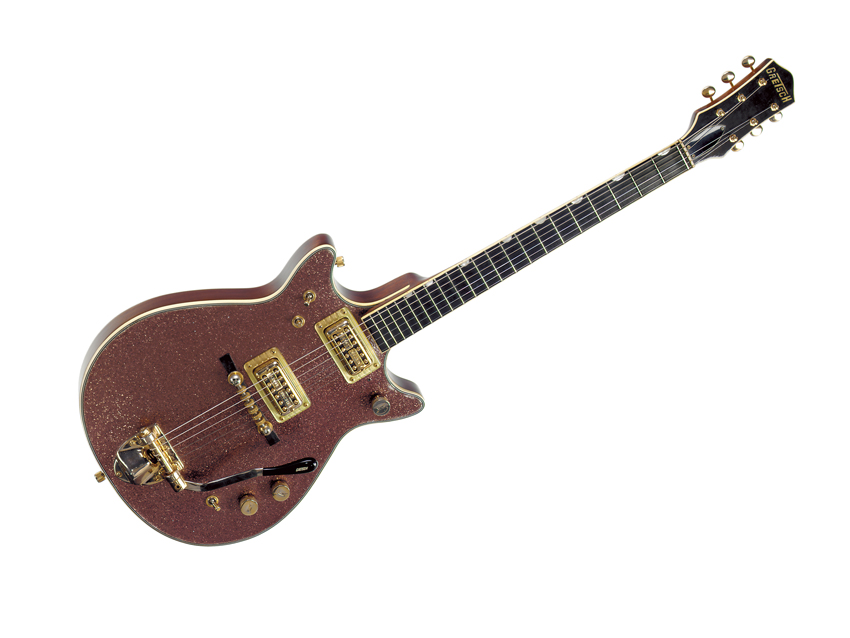
1962 Gretsch 6129 Burgundy Silver Jet
PRICE: $20,315
LOT 52 CHRISTIE’S 2004
EST: $4,000 - $6,000
Serial No: 46387
Body: Mahogany, burgundy sparkle Nitron top, bound
Neck: Mahogany, 21 frets, bound ebony fingerboard
Headstock: Bound
Bridge: Gold-plated ‘space control’ bridge, gold-plated Burns vibrato
Pickups: Two humbucking Filter’Tron with gold-plated covers
Controls: Three volume (master, neck pickup, bridge pickup)
Switches: Three-position pickup selector, three-position tone colour, two-position standby
Case: Original hardshell case with adhesive tape inscribed ‘Auction #29 1962/ Champagne Sparkle/Roc Jet #46387’
The Silver Jet was one of several models that Gretsch introduced in 1954 to compete with the Gibson Les Paul. With its sparkling silver Nitron top – the same material Gretsch used to cover drums – it is even more eye-catching and flashy than the Les Paul’s early 1950s gold top finish. Like Gretsch’s other ‘solid body’ models of the day, the Silver Jet actually wasn’t solid at all, but rather featured a hollowed-out mahogany body.
When Gibson switched the Les Paul’s design to the double-cutaway ‘SG’ shape in 1961, Gretsch also followed suit by changing the Duo Jet, Jet Firebird, and Silver Jet to double-cutaway models in 1962. In typical Gretsch fashion they took their ‘one-upmanship’ even further by using gold-plated parts and offering the Silver Jet with a choice of silver, burgundy, champagne, gold, or tangerine Nitron sparkle tops.
The latter four options were available by custom order only, but even though Gretsch didn’t charge extra for the optional colours only a few buyers took up their offer. When Pete Alenov of Pete’s Guitar in St. Paul, Minnesota, brought this stunning 1962 Gretsch ‘burgundy’ Jet backstage to a concert, Clapton found the guitar impossible to resist.
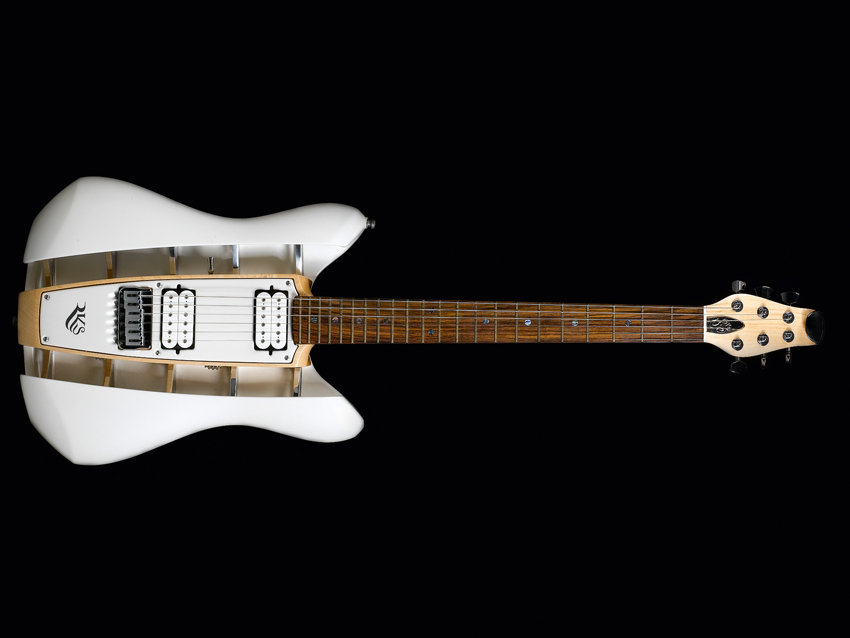
2005v RKS Original Hollowbody
PRICE: $5,500
LOT 65 BONHAMS 2011
EST: $1,200 - $1,800
Serial No: V25 583
Body: Maple/alder neck-through-body construction, hollow-moulded composite shell wings with aluminium ribs, Ocean Pearl finish
Neck: Maple, 22 frets, rosewood fingerboard with abalone dot inlays
Headstock: White metal plaque engraved with ‘Om’ motif
Bridge: Strings-through-body nickel-plated bridge baseplate with six adjustable saddles
Pickguard: Composite with RKS logo
Pickups: Two humbucking
Controls: Internally mounted volume and tone
Switches: Internally mounted three-position pickup selector
Additional: Hexagonal keys, three picks
Case: Black rectangular hardshell case with black plush lining, handwritten label with various inscriptions including ‘RKS ‘Dr Who Special’ V25 583, Gift from Dave Mason, R.A.H. 05.’
American industrial designer Ravi K. Sawhney is the founder and CEO of RKS, a company known for its award-winning appliance, home electronics, kitchen utensil, and medical equipment product designs and for its role in the development of the Panaflex Millennium XL camera system. Sawhney also helped develop touchscreen technology and the Teddy Ruxpin animatronic talking toy bear. In 2000 Sawhney conceived an innovative and unusual new guitar design, which inspired him to go into business as a guitar manufacturer.
Ravi’s brother Ramesh introduced Ravi to his friend, guitarist/singer Dave Mason, who agreed to become a company partner and provide RKS Guitars with valuable constructive criticism about the guitar’s design from his perspective as a professional musician. RKS developed a variety of solidbody and hollowbody models, all based upon a basic neck-through-body design with innovative wings that attached to the centre section with aluminum ribs that enhanced resonance.
The guitar’s distinctive body shape was allegedly based on the curvaceous hips of an unspecified famous singer/actress. Although the design world, guitar magazines, and a handful of players brave enough to stray from the comfort of traditional instruments praised Sawhney’s visionary designs, RKS Guitars produced guitars only for a very brief period from 2003 through 2007. The biggest problem was the expensive price tag for their initial models.
By the time RKS introduced its first affordable models it was too late as the company’s profits were already experiencing a severe decline. Mason, who toured with Clapton as a member of Delaney and Bonnie and Friends in 1969, personally gave this guitar to Clapton as a gift during the Cream reunion concerts at Royal Albert Hall in May 2005.

Circa 1865 John C. Haynes Titlton guitar
PRICE: $26,290
LOT 21 CHRISTIE’S 2004
EST: $2,000 - $3,000
Serial No: 2/2063
Body: Rosewood back and sides, spruce top, sycamore binding, natural finish
Neck: Mahogany, 18 frets, ebony fingerboard
Headstock: Slotted
Bridge: Ebony, silver-plated copper trapeze tailpiece with silver-plated medallions engraved ‘Awarded to Zogbaum & Fairchild. For the best guitarists. Tilton’s Patent 1865. American Institute. New York. Lovett.’
Case: Period wood ‘coffin’ case labelled ‘HART & SON/28 WARDOUR STREET/LONDON. W.,’ with adhesive tape inscribed ‘‘LIGVODER’/Auction #50/Tilton’
ERIC: "This was a birthday or Christmas present from my first wife. For a long time I couldn’t figure out what the hell it was and then it turned into a legend in its own right for other reasons – it became a story. I created a legend around it, which is completely fictitious. People would always ask if it ever appeared anywhere and if I had it in the studio with the case open people would just walk into it like a baited trap."

Joe is a freelance journalist who has, over the past few decades, interviewed hundreds of guitarists for Guitar World, Guitar Player, MusicRadar and Classic Rock. He is also a former editor of Guitar World, contributing writer for Guitar Aficionado and VP of A&R for Island Records. He’s an enthusiastic guitarist, but he’s nowhere near the likes of the people he interviews. Surprisingly, his skills are more suited to the drums. If you need a drummer for your Beatles tribute band, look him up.
“Its mission is simple: unleash the power of any amplifier or line-level source without compromise”: Two Notes promises a “watershed” in tube amp control with the Torpedo Reload II
“A pedal that sings with harmonic richness and blooming touch response”: Tone King offers up boutique tube amp tones for your pedalboard with the Imperial Preamp
“Its mission is simple: unleash the power of any amplifier or line-level source without compromise”: Two Notes promises a “watershed” in tube amp control with the Torpedo Reload II
“A pedal that sings with harmonic richness and blooming touch response”: Tone King offers up boutique tube amp tones for your pedalboard with the Imperial Preamp









